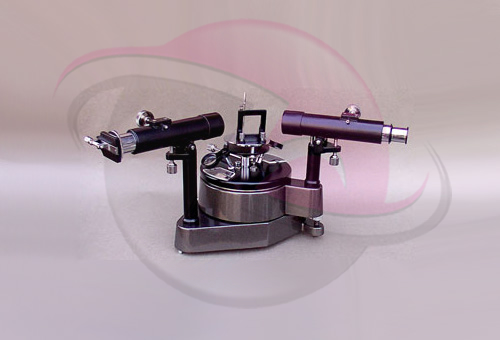Spectrometer

Spectrometer
Scale: The 150 mm diameter circle with protective plastic shield is fixed to the telescope movement and the table is attached to the double ended vernier which reads 30 seconds of the arc. Both telescope and table rotations have fine adjustment screws, and release of a clamping screw enables adjustments of both movements to be made by hand.
Collimator: Mounted on fixed pillar and fitted with 178 mm focus, 32 mm achromatic objective with 28 mm clear aperture. Also fitted is a unilaterally adjustable slit 7 mm long.
Telescope: Mounted on moveable pillar and fitted with 178 mm focus, 32 mm achromatic objective with 28 mm clear aperture. Also fitted is a 10x Ramsden eyepiece and a glass cross line graticule. Both the telescope and the collimator have rack and pinion focusing.
Prism table: The table is marked with lines to assist placing the prism with respect to the table leveling screws.
Standard accessories supplied:
1 Prism clamp
1 Diffraction grating holder
1 Magnifier bi-focal
1 Tommy bar for adjusting optical axes
1 Plywood case
Comprehensive setting up instructions also provided. Supplied WITHOUT prism.
A spectrometer is a scientific instrument used to separate and measure spectral components of a physical phenomenon. Spectrometer is a broad term often used to describe instruments that measure a continuous variable of a phenomenon where the spectral components are somehow mixed.
Resolution
Generally, the resolution of an instrument tells us how well two close-lying energies (or wavelengths, or frequencies, or masses) can be resolved. Generally, for an instrument with mechanical slits, higher resolution will mean lower intensity.
A spectrometer is any instrument that's used to measure the variation of a physical characteristic over a given range, i.e. a spectrum. This could be a mass-to-charge ratio spectrum in a mass spectrometer, the variation of nuclear resonant frequencies in a nuclear magnetic resonance (NMR) spectrometer, or the change in the absorption and emission of light with wavelength in an optical spectrometer. The mass spectrometer, NMR spectrometer and the optical spectrometer are the three most common types of spectrometers found in research labs around the world.
A spectrometer measures the wavelength and frequency of light, and allows us to identify and analyse the atoms in a sample we place within it. In their simplest form, spectrometers act like a sophisticated form of diffraction, somewhat akin to the play of light that occurs when white light hits the tiny pits of a DVD or other compact disk.
Light is passed from a source (which has been made incandescent through heating) to a diffraction grating (much like an artificial Fraunhofer line) and onto a mirror. As the light emitted by the original source is characteristic of its atomic composure, diffracting and mirroring first disperses, then reflects, the wavelength into a format that we can detect and quantify.
The colorful rings that result from this simple arrangement, even in normal room light, are quite amazing, and will prompt discussions of light interference, refraction, and the visible spectrum. Apparatus
